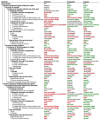Injury Profile SIMulator, a qualitative aggregative modelling framework to predict crop injury profile as a function of cropping practices, and the abiotic and biotic environment. I. Conceptual bases
- PMID: 24019908
- PMCID: PMC3760918
- DOI: 10.1371/journal.pone.0073202
Injury Profile SIMulator, a qualitative aggregative modelling framework to predict crop injury profile as a function of cropping practices, and the abiotic and biotic environment. I. Conceptual bases
Abstract
The limitation of damage caused by pests (plant pathogens, weeds, and animal pests) in any agricultural crop requires integrated management strategies. Although significant efforts have been made to i) develop, and to a lesser extent ii) combine genetic, biological, cultural, physical and chemical control methods in Integrated Pest Management (IPM) strategies (vertical integration), there is a need for tools to help manage Injury Profiles (horizontal integration). Farmers design cropping systems according to their goals, knowledge, cognition and perception of socio-economic and technological drivers as well as their physical, biological, and chemical environment. In return, a given cropping system, in a given production situation will exhibit a unique injury profile, defined as a dynamic vector of the main injuries affecting the crop. This simple description of agroecosystems has been used to develop IPSIM (Injury Profile SIMulator), a modelling framework to predict injury profiles as a function of cropping practices, abiotic and biotic environment. Due to the tremendous complexity of agroecosystems, a simple holistic aggregative approach was chosen instead of attempting to couple detailed models. This paper describes the conceptual bases of IPSIM, an aggregative hierarchical framework and a method to help specify IPSIM for a given crop. A companion paper presents a proof of concept of the proposed approach for a single disease of a major crop (eyespot on wheat). In the future, IPSIM could be used as a tool to help design ex-ante IPM strategies at the field scale if coupled with a damage sub-model, and a multicriteria sub-model that assesses the social, environmental, and economic performances of simulated agroecosystems. In addition, IPSIM could also be used to help make diagnoses on commercial fields. It is important to point out that the presented concepts are not crop- or pest-specific and that IPSIM can be used on any crop.
Conflict of interest statement
Figures





References
-
- Fess TL, Kotcon JB, Benedito VA (2011) Crop breeding for low input agriculture: a sustainable response to feed a growing world population. Sustainability 3: 1742–1772.
-
- Kropff MJ, Bouma J, Jones JW (2001) Systems approaches for the design of sustainable agro-ecosystems. Agricultural Systems 70: 369–393.
-
- Kropff MJ, Teng PS, Rabbinge R (1995) The challenge of linking pest and crop models. Agricultural Systems 49: 413–434.
-
- Birch ANE, Begg GS, Squire GR (2011) How agro-ecological research helps to address food security issues under new IPM and pesticide reduction policies for global crop production systems. Journal of Experimental Botany 62: 3251–3261. - PubMed
-
- Ferron P, Deguine JP (2005) Crop protection, biological control, habitat management and integrated farming. A review. Agronomy for Sustainable Development 25: 17–24.
Publication types
MeSH terms
LinkOut - more resources
Full Text Sources
Other Literature Sources

